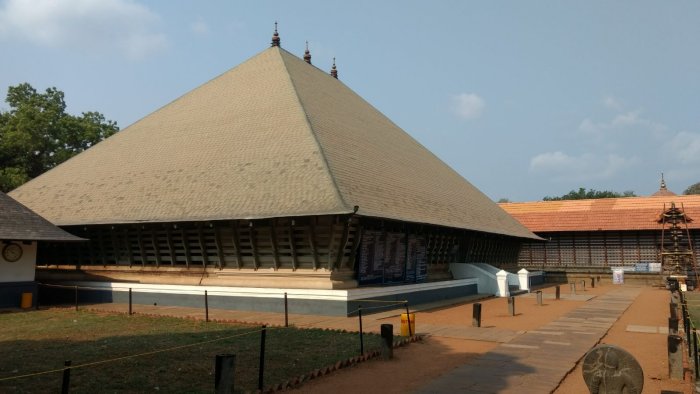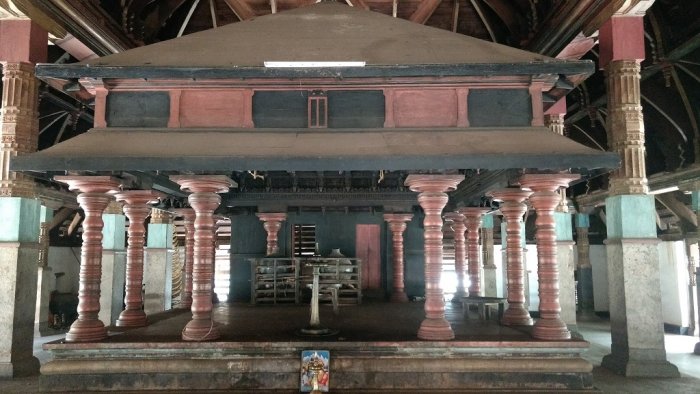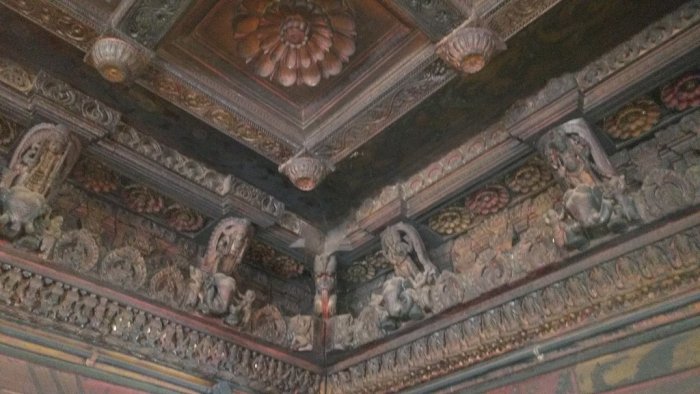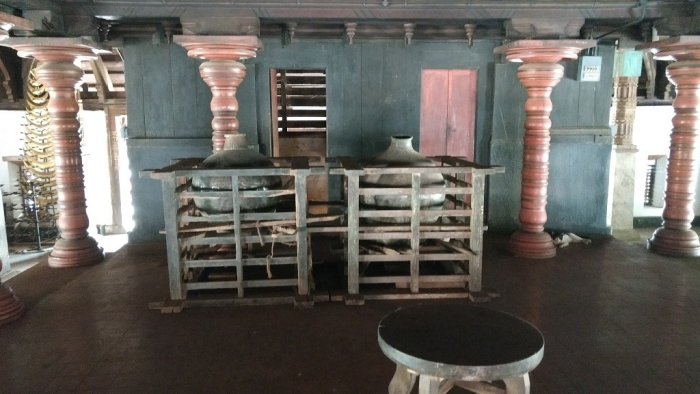 |
 |
 |
 |
Koothambalam: The performance theatres in Kerala temples - Haritha Haridas e-mail: harithaharidas84@gmail.com Photos: Haritha Haridas May 8, 2020 Concept of a Koothambalam The Koothambalam or Nrtta Mandapa came into existence during the day of Bharata. Bharatamuni in his extant Natya Sastra has in fact written an entire chapter on the construction of an auditorium for theatre. Though there is a legend associated with the necessity of an auditorium, practically Bharata believed in providing a specifically erected enclosed space for theatre to make it more aesthetic. Earlier, there were not any particular spaces for performing arts; performances were conducted in any open space or on temporarily erected stages and even on streets.  Koothambalam at Vadakkunnathan Temple, Thrissur As a result, the category of audience began to change. Mostly only invitees were present or those who were genuinely interested in the art form. The big audience began to disappear after transforming theatre to Natyadharmi. The Nrtta Mandapa would have a capacity of 150 to 200 people which actually helped them closely observe satvika abhinaya. The square shape is the basis of all Indian architecture as it can contain any shape like the circle, triangle, octagon etc and also can be extended to a rectangle. Square is considered ideal as it emulates the shape of the Vedic homa kunda; it is associated with divine beings in Vedic rituals and hence considered suitable for building temples. Koothambalam is square or rectangular and arrived at after the process of addition, subtraction, multiplication or division mentioned in the slokas of Silparatna pertaining to theatre. The architecture of the Koothambalam reflects that of the temple. It is considered as one of the Prasadas of the temple. The character and identity of a temple is determined by the architecture of its srikovil. Srikovil is the nucleus of a temple complex. Some of its salient features: * To remove all external disturbances. It is said that after entering into the Koothambalam, it should be equivalent to entering a cave devoid of any distractions and complete obliviousness from the outside world. This helped in creating an atmosphere of divinity and hence, uphold its sanctity as a divine structure.  * Unlike the present day proscenium theatre where there is quite a distance between the performer and the audience since the stage is much higher, the Arangu at a Koothambalam, although a raised platform, is not very high. Thus, it ensures a healthy interaction between the performer and the audience. The audience seated on the ground would be completely involved in the performance. * if the theme is Karuna, then the respective visual arts should also depict the same bhava. They should be miniatures of mythological stories compatible to the theme.  * There shouldn't be any background for the stage and any concept depicted was entirely dependent on the angika abhinaya of the actor. * Acoustics are given utmost importance. There should be no echo present and hence acoustic friendly. The actor should be able to deliver his voice till last end of his/her audience. The 3 types of Natyagrahas mentioned in Bharata's Natya Sastra according to size and dimensions (biggest, middle and small sizes) also ensures the same. The 3 types according to their shapes are Vikrsta - oblong, Chaturasra - rectangular and Tryasra - triangular. Hence to avoid echoes, there would be openings on either sides of the structure especially between the trellis walls of the mandapam. * Akin to the green rooms found in current day auditoriums, Koothambalams have a dressing room called Nepathya or Aniyara. It would mostly have 2 doors from the Rangamandapa, one for exit and one for entrance. There would also be a door leading to the pathway behind Rangamandapa. * Lighting is not given much importance as there would be mostly just big traditional lamps (Vilakku) that would be lit and Vilakku was an integral part of the performance. Once the Vilakku has been lit, the performer becomes completely involved in his character. The Vilakku is considered as the deity instead of the temple's presiding deity. * Consecration of a Koothambalam is an important ritual as the structure is considered divine. Performance The Koothambalam is used for staging Koothu - Chakyar or Nangyar Koothu - and Koodiyattam, an ancient ritualistic art form of Central Kerala. The Chakyarkoothu performers are collectively known as Chakyars. They are hereditary actors from Kerala mostly doing solo acts in Sanskrit plays. The single act can go on for several days. It is necessary to enact a prelude to the original theme to be presented. That portion where a flashback is performed is called Nirvahana. The act begins properly only during the last 2 days when all the characters come together to be enacted by a single Chakyar, hence the name Koodiyattam meaning 'joint acting,' also referred to as Koothu. Two legendary Chakyarkoothu doyens are Mani Madhava Chakyar and Ammanur Madhava Chakyar. The legacy is taken forward by eminent Guru G. Venu and his talented daughter Kapila Venu.  The only accompanying instruments used are 2 mizhavus and an edakka, both percussion instruments. The 2 mizhavus are permanently fixed on the Ranga Mandapa of the Koothambalam. One of the mizhavus is the main one which controls the entire act and the other one is used to fill up any gaps during talam. Mizhavus are also consecrated like the Koothambalam itself and once it is spoilt out of usage, it is given royal funeral rituals. These mizhavus are placed almost in front of the doors to the Nepathya. Though Koothu was originally in Sanskrit, the regionalized version came up in the 9th -10th century A.D and hence started using Manipravalam (mixture of Sanskrit and Malayalam). The maintenance of the Natakasala and the performers were ensured by the royalty and common men through generous endowments of cash and kind. The Koothu was considered divine and was in fact one of the 16 upacharas or rituals conducted at the temple for the propitiation of the deity. The Chakyar was considered next to the temple head priest. He receives the Vilakku from the priest after pooja. During a performance, there wouldn't be any pooja at the Srikovil or vice versa as the deity's presence should be present at the ritual as a whole, hence shouldn't be divided. The deity should be present at the time of the performance at the Koothambalam as Koothu was sacred. The Koothambalam was considered almost equivalent to the Srikovil, hence Koothambalam was treated like a temple. Some of the most famous Koothambalams are found in temples such as Vadakkunnathan Temple in Thrissur, Guruvayoor Sri Krishna Temple, Koodalmanikyam Temple in Irinjalakkuda, Mahadeva Temple in Peruvanam in Thrissur district, Subramanya temple in Harippad. Bibliography & References * Dr.K.G Paulose (Sanskrit scholar) - Primary source through conversations and direct notes at his residence * Panchal, Govardhan - Kuttu and Kuttampalam * Rangacharya, Adya - The Natyasastra (English Translation with Critical Notes) Thanks to the Devaswom (temple administration) at Vadakkunnathan temple for permission to see and take pictures of the Koothambalam (interior & exterior). Haritha Haridas, disciple of Shyamala Surendran, is a Mohiniyattam and Bharatanatyam dancer and teacher (Medasvi School of Dance) based in Singapore. She has an MFA in Bharatanatyam from Sastra University under Dr. Padma Subrahmayam. Post your comments Please provide your name and email id when you use the Anonymous profile in the blog to post a comment. All appropriate comments posted with name & email id in the blog will also be featured in the site. |